Participation Rights vs. Protection Rights: A Child's Perspective
VerifiedAdded on 2023/06/03
|8
|2065
|422
Essay
AI Summary
This essay delves into the critical debate surrounding child rights, specifically contrasting participation and protection rights within the context of child abuse in Australia. The paper references the UNICEF's Convention on the Rights of the Child, highlighting the importance of both participation, which emphasizes a child's voice in matters concerning them, and protection, which aims to safeguard children from various forms of abuse. The essay explores the complexities of ensuring participation rights, acknowledging the challenges of manipulation and the limitations of a child's perspective while emphasizing the need for children to be heard and their views respected. It argues that while participation rights are vital, protection rights are paramount, given the vulnerabilities of children. The essay concludes by asserting that protection rights are more poignant in safeguarding children from various forms of abuse, including labor, sexual violence, and neglect, although participation rights remain significant. References to key articles within the Convention and the works of various authors provide a solid foundation for the arguments presented.

Running head: PARTICIPATION RIGHTS VERSUS PROTECTION RIGHTS
Participation rights versus protection rights
Name of student
Name of university
Participation rights versus protection rights
Name of student
Name of university
Paraphrase This Document
Need a fresh take? Get an instant paraphrase of this document with our AI Paraphraser
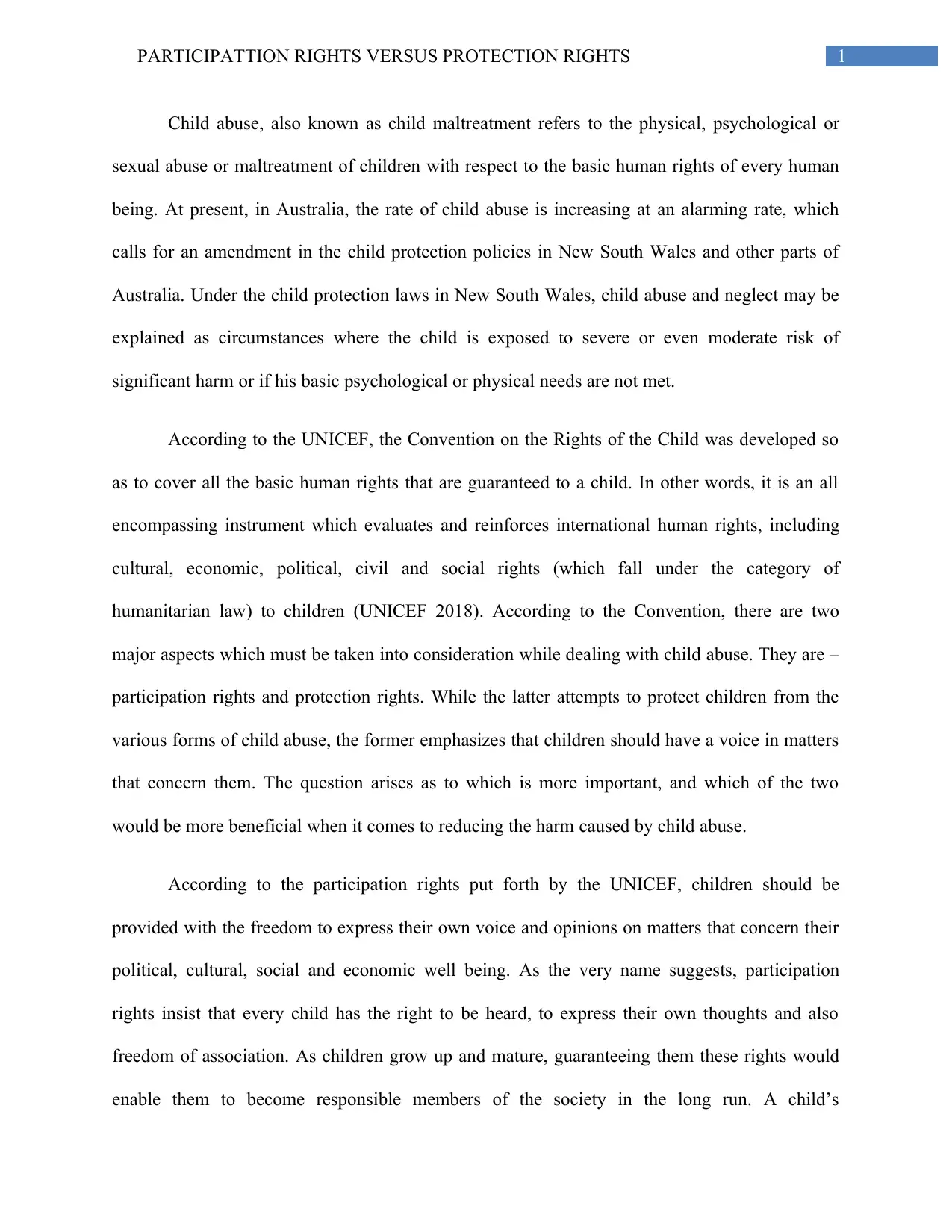
1PARTICIPATTION RIGHTS VERSUS PROTECTION RIGHTS
Child abuse, also known as child maltreatment refers to the physical, psychological or
sexual abuse or maltreatment of children with respect to the basic human rights of every human
being. At present, in Australia, the rate of child abuse is increasing at an alarming rate, which
calls for an amendment in the child protection policies in New South Wales and other parts of
Australia. Under the child protection laws in New South Wales, child abuse and neglect may be
explained as circumstances where the child is exposed to severe or even moderate risk of
significant harm or if his basic psychological or physical needs are not met.
According to the UNICEF, the Convention on the Rights of the Child was developed so
as to cover all the basic human rights that are guaranteed to a child. In other words, it is an all
encompassing instrument which evaluates and reinforces international human rights, including
cultural, economic, political, civil and social rights (which fall under the category of
humanitarian law) to children (UNICEF 2018). According to the Convention, there are two
major aspects which must be taken into consideration while dealing with child abuse. They are –
participation rights and protection rights. While the latter attempts to protect children from the
various forms of child abuse, the former emphasizes that children should have a voice in matters
that concern them. The question arises as to which is more important, and which of the two
would be more beneficial when it comes to reducing the harm caused by child abuse.
According to the participation rights put forth by the UNICEF, children should be
provided with the freedom to express their own voice and opinions on matters that concern their
political, cultural, social and economic well being. As the very name suggests, participation
rights insist that every child has the right to be heard, to express their own thoughts and also
freedom of association. As children grow up and mature, guaranteeing them these rights would
enable them to become responsible members of the society in the long run. A child’s
Child abuse, also known as child maltreatment refers to the physical, psychological or
sexual abuse or maltreatment of children with respect to the basic human rights of every human
being. At present, in Australia, the rate of child abuse is increasing at an alarming rate, which
calls for an amendment in the child protection policies in New South Wales and other parts of
Australia. Under the child protection laws in New South Wales, child abuse and neglect may be
explained as circumstances where the child is exposed to severe or even moderate risk of
significant harm or if his basic psychological or physical needs are not met.
According to the UNICEF, the Convention on the Rights of the Child was developed so
as to cover all the basic human rights that are guaranteed to a child. In other words, it is an all
encompassing instrument which evaluates and reinforces international human rights, including
cultural, economic, political, civil and social rights (which fall under the category of
humanitarian law) to children (UNICEF 2018). According to the Convention, there are two
major aspects which must be taken into consideration while dealing with child abuse. They are –
participation rights and protection rights. While the latter attempts to protect children from the
various forms of child abuse, the former emphasizes that children should have a voice in matters
that concern them. The question arises as to which is more important, and which of the two
would be more beneficial when it comes to reducing the harm caused by child abuse.
According to the participation rights put forth by the UNICEF, children should be
provided with the freedom to express their own voice and opinions on matters that concern their
political, cultural, social and economic well being. As the very name suggests, participation
rights insist that every child has the right to be heard, to express their own thoughts and also
freedom of association. As children grow up and mature, guaranteeing them these rights would
enable them to become responsible members of the society in the long run. A child’s

2PARTICIPATTION RIGHTS VERSUS PROTECTION RIGHTS
understanding of human rights and their importance would depend on the level of participation in
their developing years. The Article 12 of the Convention states that children have the basic
human right to partake in decision making processes which are relevant to them. The
foundational principle of UNICEF’s participation right is that every child is a full fledged person
and thus should be entitled the rights to express their individual views (UNICEF 2018). In fact,
the rights also claim that the viewpoints of these children should be given due importance and
weight and taken into consideration.
However, it must be argued that ensuring participation rights for children is easier said
than done. As Van Bijleveld, Dedding and Bunders – Aelen (2015) argue, imposition of
participation rights would require effective actions and clear commitment so as to convert this
into a reality. It must also be asserted that participation rights do not guarantee that the
viewpoints of the children would be automatically endorsed. This is quite obvious, given that
children have a limited perspective on the world around them. Participation rights ensure that the
views and opinions of the children are respected and taken into account. However, it is not to say
that the opinions of the children will mandatorily be enforced. In other words, children should
have the right to influence the decisions which make a difference to them. Freeman (2017)
argues that when it comes to children, manipulation is a major threat. Perceiving children to be
weaker members of the society, they are often manipulated and influenced into agreeing to
decisions which may be detrimental to their welfare. In other words, children should not be
influenced, pressurized, constrained or even manipulated into doing something which would
hamper their growth and development in the long run. In short, children should not be prevented
from expressing their own views.
understanding of human rights and their importance would depend on the level of participation in
their developing years. The Article 12 of the Convention states that children have the basic
human right to partake in decision making processes which are relevant to them. The
foundational principle of UNICEF’s participation right is that every child is a full fledged person
and thus should be entitled the rights to express their individual views (UNICEF 2018). In fact,
the rights also claim that the viewpoints of these children should be given due importance and
weight and taken into consideration.
However, it must be argued that ensuring participation rights for children is easier said
than done. As Van Bijleveld, Dedding and Bunders – Aelen (2015) argue, imposition of
participation rights would require effective actions and clear commitment so as to convert this
into a reality. It must also be asserted that participation rights do not guarantee that the
viewpoints of the children would be automatically endorsed. This is quite obvious, given that
children have a limited perspective on the world around them. Participation rights ensure that the
views and opinions of the children are respected and taken into account. However, it is not to say
that the opinions of the children will mandatorily be enforced. In other words, children should
have the right to influence the decisions which make a difference to them. Freeman (2017)
argues that when it comes to children, manipulation is a major threat. Perceiving children to be
weaker members of the society, they are often manipulated and influenced into agreeing to
decisions which may be detrimental to their welfare. In other words, children should not be
influenced, pressurized, constrained or even manipulated into doing something which would
hamper their growth and development in the long run. In short, children should not be prevented
from expressing their own views.
⊘ This is a preview!⊘
Do you want full access?
Subscribe today to unlock all pages.

Trusted by 1+ million students worldwide
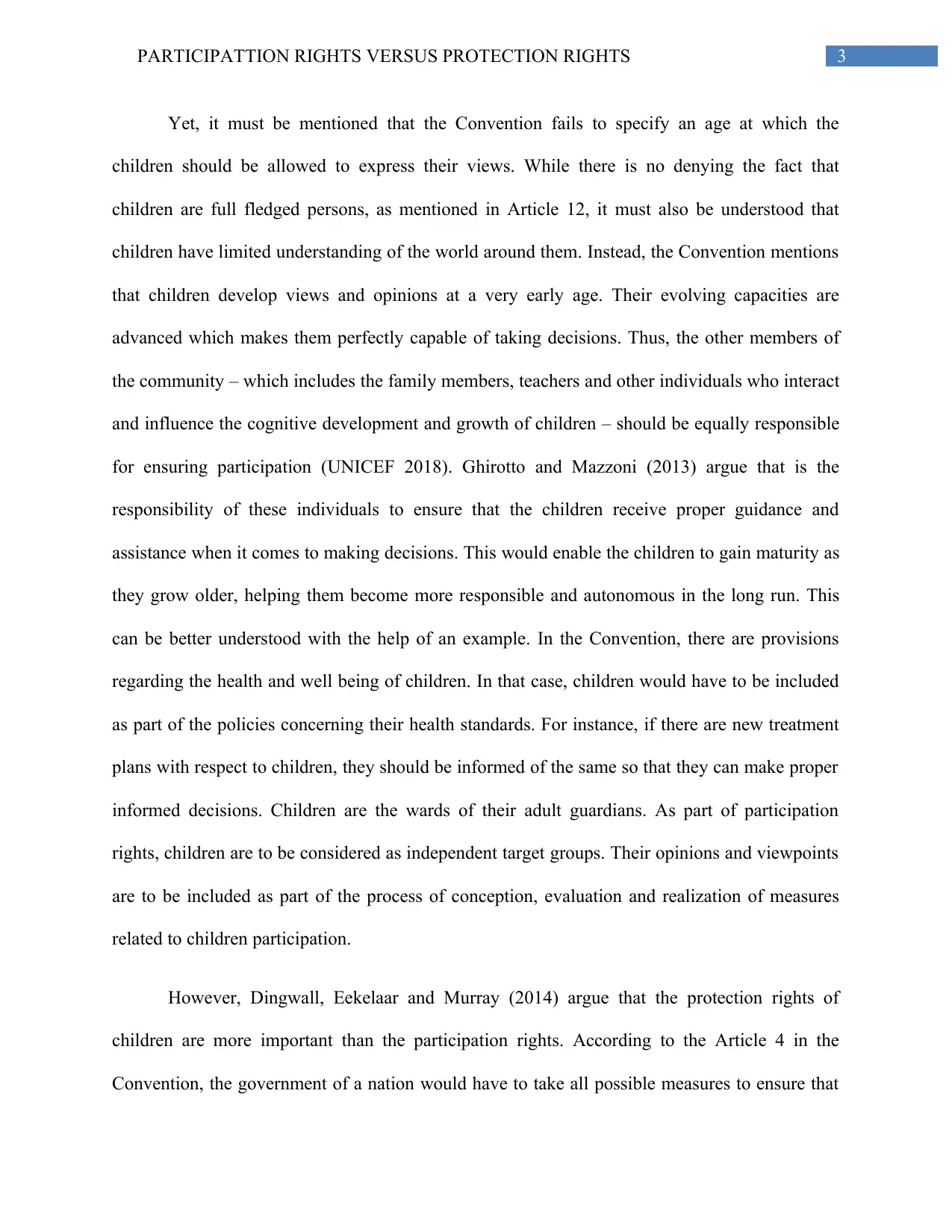
3PARTICIPATTION RIGHTS VERSUS PROTECTION RIGHTS
Yet, it must be mentioned that the Convention fails to specify an age at which the
children should be allowed to express their views. While there is no denying the fact that
children are full fledged persons, as mentioned in Article 12, it must also be understood that
children have limited understanding of the world around them. Instead, the Convention mentions
that children develop views and opinions at a very early age. Their evolving capacities are
advanced which makes them perfectly capable of taking decisions. Thus, the other members of
the community – which includes the family members, teachers and other individuals who interact
and influence the cognitive development and growth of children – should be equally responsible
for ensuring participation (UNICEF 2018). Ghirotto and Mazzoni (2013) argue that is the
responsibility of these individuals to ensure that the children receive proper guidance and
assistance when it comes to making decisions. This would enable the children to gain maturity as
they grow older, helping them become more responsible and autonomous in the long run. This
can be better understood with the help of an example. In the Convention, there are provisions
regarding the health and well being of children. In that case, children would have to be included
as part of the policies concerning their health standards. For instance, if there are new treatment
plans with respect to children, they should be informed of the same so that they can make proper
informed decisions. Children are the wards of their adult guardians. As part of participation
rights, children are to be considered as independent target groups. Their opinions and viewpoints
are to be included as part of the process of conception, evaluation and realization of measures
related to children participation.
However, Dingwall, Eekelaar and Murray (2014) argue that the protection rights of
children are more important than the participation rights. According to the Article 4 in the
Convention, the government of a nation would have to take all possible measures to ensure that
Yet, it must be mentioned that the Convention fails to specify an age at which the
children should be allowed to express their views. While there is no denying the fact that
children are full fledged persons, as mentioned in Article 12, it must also be understood that
children have limited understanding of the world around them. Instead, the Convention mentions
that children develop views and opinions at a very early age. Their evolving capacities are
advanced which makes them perfectly capable of taking decisions. Thus, the other members of
the community – which includes the family members, teachers and other individuals who interact
and influence the cognitive development and growth of children – should be equally responsible
for ensuring participation (UNICEF 2018). Ghirotto and Mazzoni (2013) argue that is the
responsibility of these individuals to ensure that the children receive proper guidance and
assistance when it comes to making decisions. This would enable the children to gain maturity as
they grow older, helping them become more responsible and autonomous in the long run. This
can be better understood with the help of an example. In the Convention, there are provisions
regarding the health and well being of children. In that case, children would have to be included
as part of the policies concerning their health standards. For instance, if there are new treatment
plans with respect to children, they should be informed of the same so that they can make proper
informed decisions. Children are the wards of their adult guardians. As part of participation
rights, children are to be considered as independent target groups. Their opinions and viewpoints
are to be included as part of the process of conception, evaluation and realization of measures
related to children participation.
However, Dingwall, Eekelaar and Murray (2014) argue that the protection rights of
children are more important than the participation rights. According to the Article 4 in the
Convention, the government of a nation would have to take all possible measures to ensure that
Paraphrase This Document
Need a fresh take? Get an instant paraphrase of this document with our AI Paraphraser
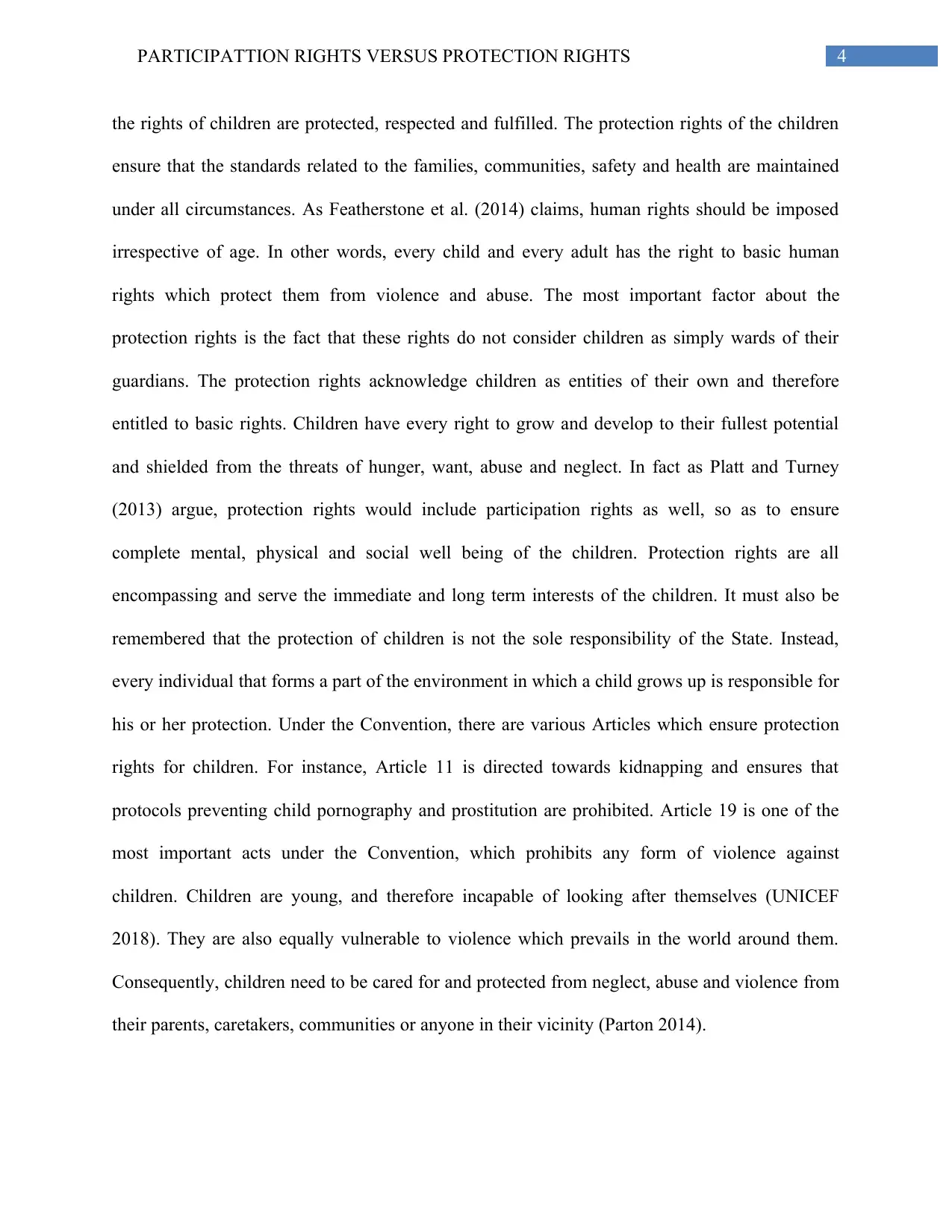
4PARTICIPATTION RIGHTS VERSUS PROTECTION RIGHTS
the rights of children are protected, respected and fulfilled. The protection rights of the children
ensure that the standards related to the families, communities, safety and health are maintained
under all circumstances. As Featherstone et al. (2014) claims, human rights should be imposed
irrespective of age. In other words, every child and every adult has the right to basic human
rights which protect them from violence and abuse. The most important factor about the
protection rights is the fact that these rights do not consider children as simply wards of their
guardians. The protection rights acknowledge children as entities of their own and therefore
entitled to basic rights. Children have every right to grow and develop to their fullest potential
and shielded from the threats of hunger, want, abuse and neglect. In fact as Platt and Turney
(2013) argue, protection rights would include participation rights as well, so as to ensure
complete mental, physical and social well being of the children. Protection rights are all
encompassing and serve the immediate and long term interests of the children. It must also be
remembered that the protection of children is not the sole responsibility of the State. Instead,
every individual that forms a part of the environment in which a child grows up is responsible for
his or her protection. Under the Convention, there are various Articles which ensure protection
rights for children. For instance, Article 11 is directed towards kidnapping and ensures that
protocols preventing child pornography and prostitution are prohibited. Article 19 is one of the
most important acts under the Convention, which prohibits any form of violence against
children. Children are young, and therefore incapable of looking after themselves (UNICEF
2018). They are also equally vulnerable to violence which prevails in the world around them.
Consequently, children need to be cared for and protected from neglect, abuse and violence from
their parents, caretakers, communities or anyone in their vicinity (Parton 2014).
the rights of children are protected, respected and fulfilled. The protection rights of the children
ensure that the standards related to the families, communities, safety and health are maintained
under all circumstances. As Featherstone et al. (2014) claims, human rights should be imposed
irrespective of age. In other words, every child and every adult has the right to basic human
rights which protect them from violence and abuse. The most important factor about the
protection rights is the fact that these rights do not consider children as simply wards of their
guardians. The protection rights acknowledge children as entities of their own and therefore
entitled to basic rights. Children have every right to grow and develop to their fullest potential
and shielded from the threats of hunger, want, abuse and neglect. In fact as Platt and Turney
(2013) argue, protection rights would include participation rights as well, so as to ensure
complete mental, physical and social well being of the children. Protection rights are all
encompassing and serve the immediate and long term interests of the children. It must also be
remembered that the protection of children is not the sole responsibility of the State. Instead,
every individual that forms a part of the environment in which a child grows up is responsible for
his or her protection. Under the Convention, there are various Articles which ensure protection
rights for children. For instance, Article 11 is directed towards kidnapping and ensures that
protocols preventing child pornography and prostitution are prohibited. Article 19 is one of the
most important acts under the Convention, which prohibits any form of violence against
children. Children are young, and therefore incapable of looking after themselves (UNICEF
2018). They are also equally vulnerable to violence which prevails in the world around them.
Consequently, children need to be cared for and protected from neglect, abuse and violence from
their parents, caretakers, communities or anyone in their vicinity (Parton 2014).
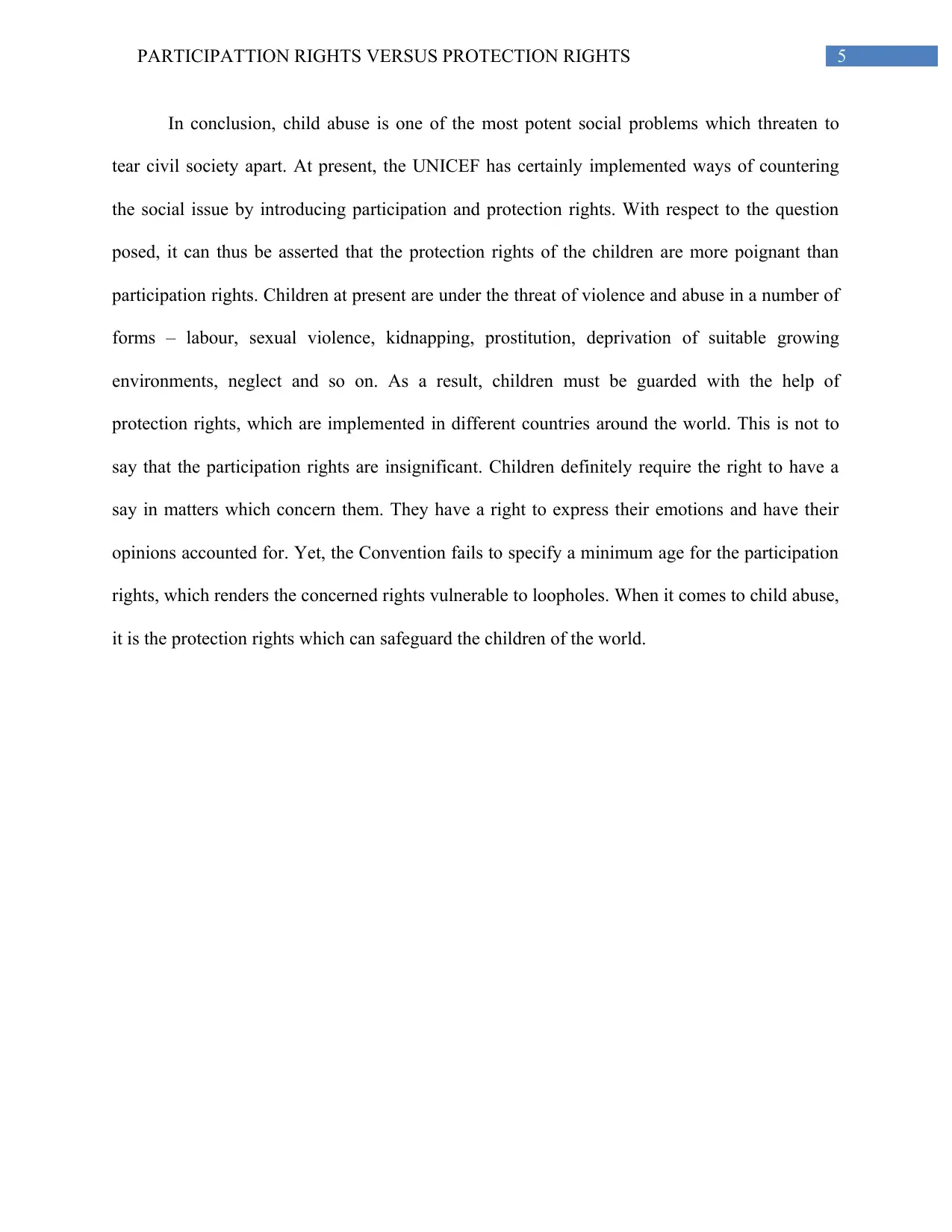
5PARTICIPATTION RIGHTS VERSUS PROTECTION RIGHTS
In conclusion, child abuse is one of the most potent social problems which threaten to
tear civil society apart. At present, the UNICEF has certainly implemented ways of countering
the social issue by introducing participation and protection rights. With respect to the question
posed, it can thus be asserted that the protection rights of the children are more poignant than
participation rights. Children at present are under the threat of violence and abuse in a number of
forms – labour, sexual violence, kidnapping, prostitution, deprivation of suitable growing
environments, neglect and so on. As a result, children must be guarded with the help of
protection rights, which are implemented in different countries around the world. This is not to
say that the participation rights are insignificant. Children definitely require the right to have a
say in matters which concern them. They have a right to express their emotions and have their
opinions accounted for. Yet, the Convention fails to specify a minimum age for the participation
rights, which renders the concerned rights vulnerable to loopholes. When it comes to child abuse,
it is the protection rights which can safeguard the children of the world.
In conclusion, child abuse is one of the most potent social problems which threaten to
tear civil society apart. At present, the UNICEF has certainly implemented ways of countering
the social issue by introducing participation and protection rights. With respect to the question
posed, it can thus be asserted that the protection rights of the children are more poignant than
participation rights. Children at present are under the threat of violence and abuse in a number of
forms – labour, sexual violence, kidnapping, prostitution, deprivation of suitable growing
environments, neglect and so on. As a result, children must be guarded with the help of
protection rights, which are implemented in different countries around the world. This is not to
say that the participation rights are insignificant. Children definitely require the right to have a
say in matters which concern them. They have a right to express their emotions and have their
opinions accounted for. Yet, the Convention fails to specify a minimum age for the participation
rights, which renders the concerned rights vulnerable to loopholes. When it comes to child abuse,
it is the protection rights which can safeguard the children of the world.
⊘ This is a preview!⊘
Do you want full access?
Subscribe today to unlock all pages.

Trusted by 1+ million students worldwide
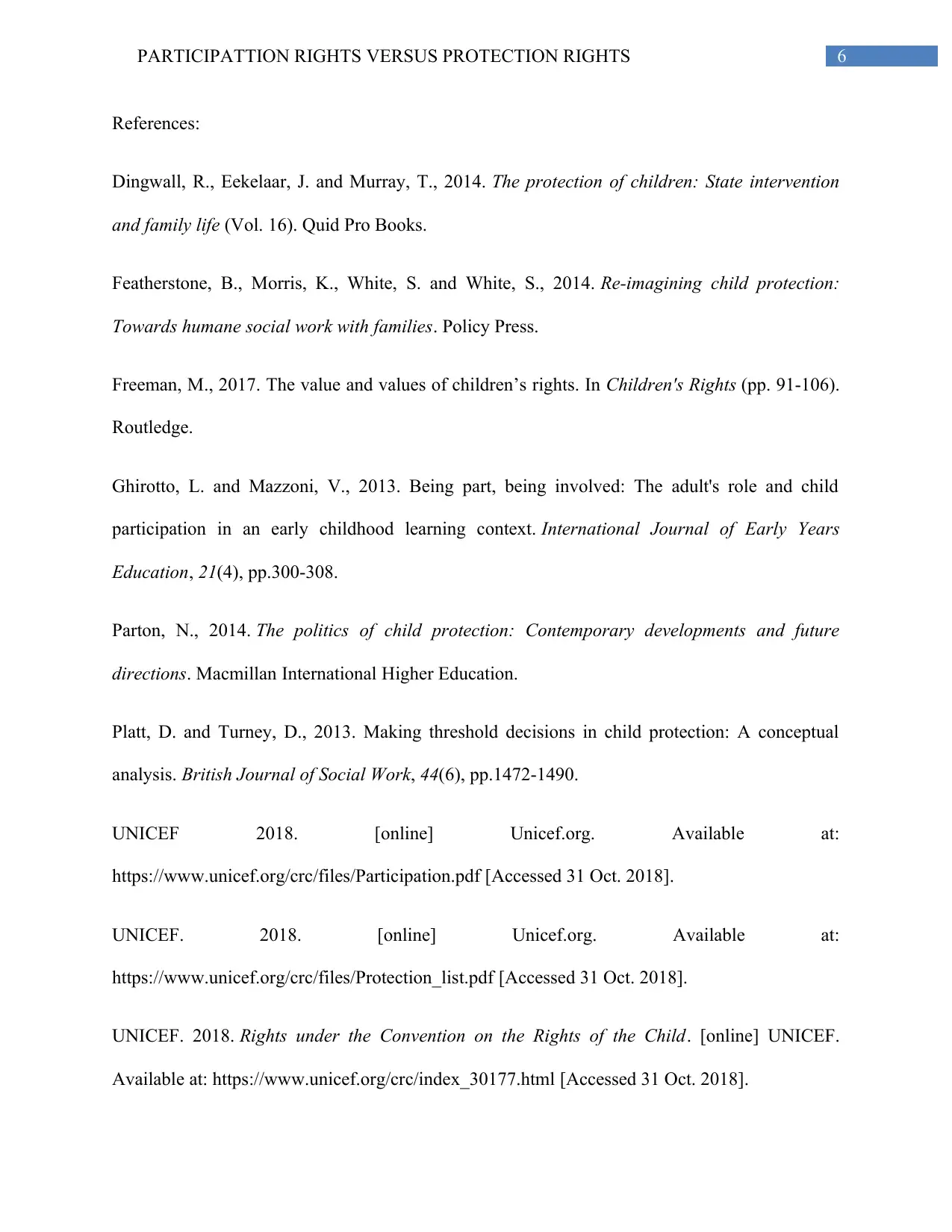
6PARTICIPATTION RIGHTS VERSUS PROTECTION RIGHTS
References:
Dingwall, R., Eekelaar, J. and Murray, T., 2014. The protection of children: State intervention
and family life (Vol. 16). Quid Pro Books.
Featherstone, B., Morris, K., White, S. and White, S., 2014. Re-imagining child protection:
Towards humane social work with families. Policy Press.
Freeman, M., 2017. The value and values of children’s rights. In Children's Rights (pp. 91-106).
Routledge.
Ghirotto, L. and Mazzoni, V., 2013. Being part, being involved: The adult's role and child
participation in an early childhood learning context. International Journal of Early Years
Education, 21(4), pp.300-308.
Parton, N., 2014. The politics of child protection: Contemporary developments and future
directions. Macmillan International Higher Education.
Platt, D. and Turney, D., 2013. Making threshold decisions in child protection: A conceptual
analysis. British Journal of Social Work, 44(6), pp.1472-1490.
UNICEF 2018. [online] Unicef.org. Available at:
https://www.unicef.org/crc/files/Participation.pdf [Accessed 31 Oct. 2018].
UNICEF. 2018. [online] Unicef.org. Available at:
https://www.unicef.org/crc/files/Protection_list.pdf [Accessed 31 Oct. 2018].
UNICEF. 2018. Rights under the Convention on the Rights of the Child. [online] UNICEF.
Available at: https://www.unicef.org/crc/index_30177.html [Accessed 31 Oct. 2018].
References:
Dingwall, R., Eekelaar, J. and Murray, T., 2014. The protection of children: State intervention
and family life (Vol. 16). Quid Pro Books.
Featherstone, B., Morris, K., White, S. and White, S., 2014. Re-imagining child protection:
Towards humane social work with families. Policy Press.
Freeman, M., 2017. The value and values of children’s rights. In Children's Rights (pp. 91-106).
Routledge.
Ghirotto, L. and Mazzoni, V., 2013. Being part, being involved: The adult's role and child
participation in an early childhood learning context. International Journal of Early Years
Education, 21(4), pp.300-308.
Parton, N., 2014. The politics of child protection: Contemporary developments and future
directions. Macmillan International Higher Education.
Platt, D. and Turney, D., 2013. Making threshold decisions in child protection: A conceptual
analysis. British Journal of Social Work, 44(6), pp.1472-1490.
UNICEF 2018. [online] Unicef.org. Available at:
https://www.unicef.org/crc/files/Participation.pdf [Accessed 31 Oct. 2018].
UNICEF. 2018. [online] Unicef.org. Available at:
https://www.unicef.org/crc/files/Protection_list.pdf [Accessed 31 Oct. 2018].
UNICEF. 2018. Rights under the Convention on the Rights of the Child. [online] UNICEF.
Available at: https://www.unicef.org/crc/index_30177.html [Accessed 31 Oct. 2018].
Paraphrase This Document
Need a fresh take? Get an instant paraphrase of this document with our AI Paraphraser
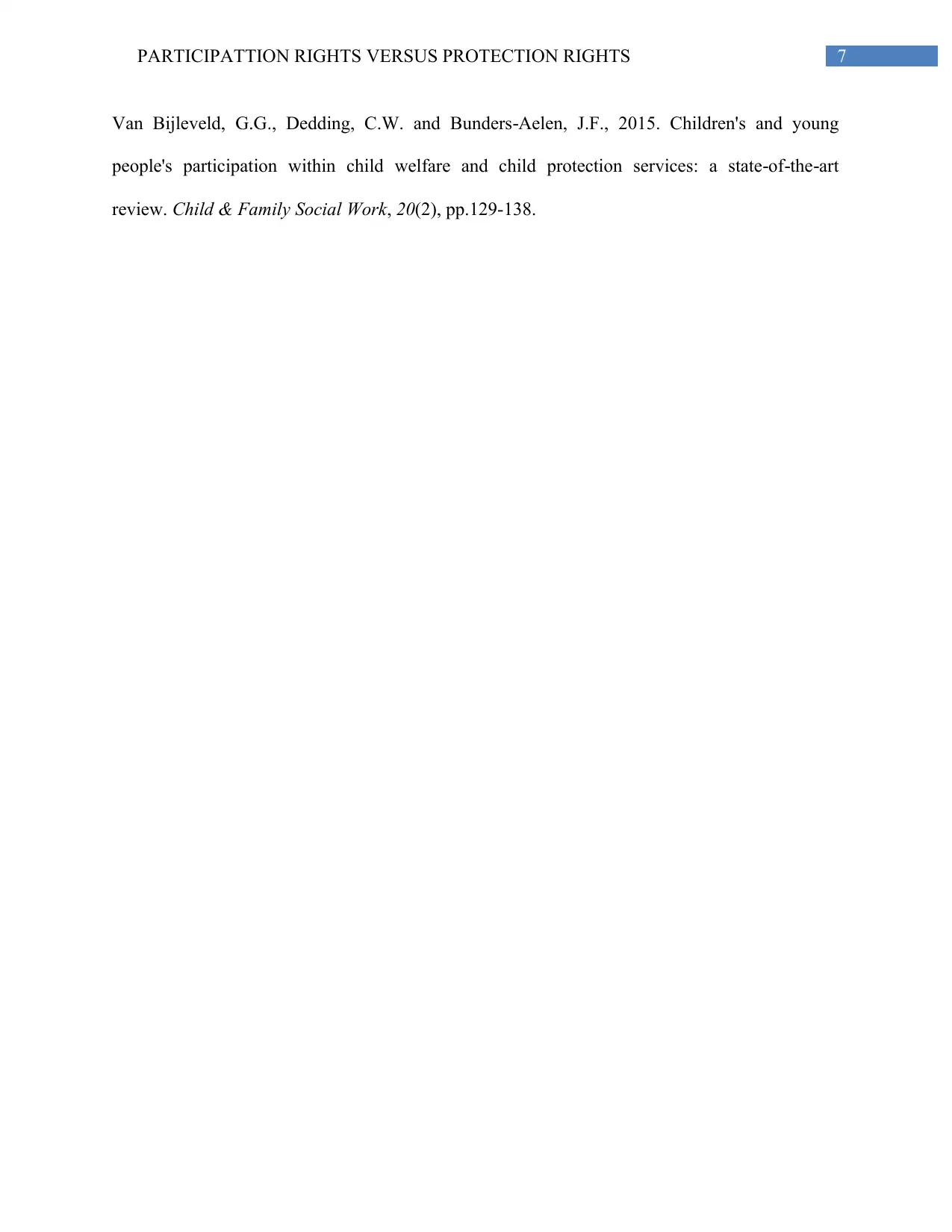
7PARTICIPATTION RIGHTS VERSUS PROTECTION RIGHTS
Van Bijleveld, G.G., Dedding, C.W. and Bunders Aelen, J.F., 2015. Children's and young‐
people's participation within child welfare and child protection services: a state of the art‐ ‐ ‐
review. Child & Family Social Work, 20(2), pp.129-138.
Van Bijleveld, G.G., Dedding, C.W. and Bunders Aelen, J.F., 2015. Children's and young‐
people's participation within child welfare and child protection services: a state of the art‐ ‐ ‐
review. Child & Family Social Work, 20(2), pp.129-138.
1 out of 8
Related Documents
Your All-in-One AI-Powered Toolkit for Academic Success.
+13062052269
info@desklib.com
Available 24*7 on WhatsApp / Email
![[object Object]](/_next/static/media/star-bottom.7253800d.svg)
Unlock your academic potential
Copyright © 2020–2025 A2Z Services. All Rights Reserved. Developed and managed by ZUCOL.





